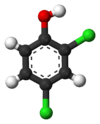2,4-Dichlorophenol
| |||
| Names | |||
|---|---|---|---|
| IUPAC name
2,4-Dichlorophenol | |||
| Identifiers | |||
| 120-83-2 | |||
| 3D model (Jmol) | Interactive image | ||
| ChEBI | CHEBI:16738 | ||
| ChEMBL | ChEMBL1143 | ||
| ChemSpider | 8140 | ||
| ECHA InfoCard | 100.004.027 | ||
| KEGG | C02625 | ||
| PubChem | 8449 | ||
| UNII | R669TG1950 | ||
| |||
| |||
| Properties | |||
| C6H4Cl2O | |||
| Molar mass | 163.00 g/mol | ||
| Appearance | White/off-white crystalline solid | ||
| Odor | Phenolic | ||
| Density | 1.38g/cm3 | ||
| Melting point | 42 to 43 °C (108 to 109 °F; 315 to 316 K) | ||
| Boiling point | 209 to 210 °C (408 to 410 °F; 482 to 483 K) | ||
| 5 g/100mL | |||
| Hazards | |||
| Safety data sheet | External MSDS | ||
| R-phrases | R22 R24 R34 R51/53 | ||
| S-phrases | S26 S36/37/39 S45 S61 | ||
| NFPA 704 | |||
| Flash point | 114 °C (237 °F; 387 K) | ||
| Lethal dose or concentration (LD, LC): | |||
| LD50 (median dose) |
47.0 mg/kg (Oral in rats) 790.0 mg/kg (Dermal exposure in mammals) | ||
| Except where otherwise noted, data are given for materials in their standard state (at 25 °C [77 °F], 100 kPa). | |||
| | |||
| Infobox references | |||
2,4-Dichlorophenol (2,4-DCP) is a chlorinated derivative of phenol with the molecular formula C6H4Cl2O. 2,4-DCP is used primarily as an intermediate in the preparation of the herbicide 2,4-dichlorophenoxyacetic acid (2,4-D). Annual worldwide production is estimated at 88 million pounds.[1] It is also a photo-degradation product of the common antibacterial and antifungal agent triclosan along with the dioxin 2,8-dichlorodibenzo-p-dioxin.[2][3]
Liquid (molten) 2,4-DCP is readily absorbed through the skin and contact with large amounts may be fatal.[4] Solid 2,4-DCP does not readily absorb through skin and has a lower NFPA H=3 rating (versus H=4 for molten 2,4-DCP). This is primarily caused by instantaneous renal failure, liver damage and various other organ failure.
See also
References
- ↑ Desmurs J, Ratton S. Chlorophenols. In: Kirk-Othmer Encyclopedia of Chemical Technology, 4th Edition. Kroschwitz JI, Howe-Grant M, eds. New York: John Wiley and Sons, 1993;6:156-168
- ↑ Singer H, Muller S, Tixier C, Pillonel L (2002). "Triclosan: occurrence and fate of a widely used biocide in the aquatic environment: field measurements in wastewater treatment plants, surface waters, and lake sediments.". Environ Sci Technol. 36 (23): 4998–5004. doi:10.1021/es025750i. PMID 12523412.
- ↑ Latch DE, Packer JL, Stender BL, VanOverbeke J, Arnold WA, McNeill K (2005). "Aqueous photochemistry of triclosan: formation of 2,4-dichlorophenol, 2,8-dichlorodibenzo-p-dioxin, and oligomerization products". Environ. Toxicol. Chem. 24 (3): 517–25. doi:10.1897/04-243R.1. PMID 15779749.
- ↑ Kintz P, Tracqui A, Mangin P (1992). "Accidental death caused by the absorption of 2,4-dichlorophenol through the skin". Arch. Toxicol. 66 (4): 298–9. doi:10.1007/BF02307178. PMID 1514931.


